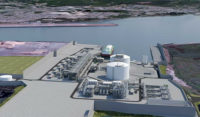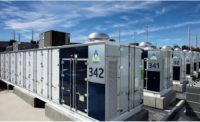Federal approval of a $4.25 billion liquefied natural gas export plant and associated pipeline in Louisiana, based on a new approach that considered direct greenhouse gas emissions for the first time, could signal improved possibilities for approval of 12 pending LNG projects.
Construction on the Venture Global Calcasieu Pass LNG export project and TransCameron pipeline is expected to start immediately.
“I anticipate we’ll be able to use the framework developed in this order to evaluate the other LNG certificates that the commission is considering,” Chairman Neil Chatterjee said following the Feb. 21 decision, adding that FERC’s multi-pronged approach to improve its process put it in a position to move forward “efficiently” with the pending projects.
The commission has long been at odds over how to handle consideration of greenhouse gases in pipelines and LNG projects, and that disagreement was one of many issues that had prevented any LNG terminals from being approved over the last two years.
The new approach earned the vote of one of the commission’s two Democrats, but with reservations, in a 3-1 decision.
Democrat Cheryl LaFleur, in her statement supporting approval, said the new approach is only a first step to help FERC ascribe significance to the volume of greenhouse gas emissions as part of its climate change analysis within the environmental review.
LaFleur, however, said in her statement the LNG project was not in the public interest because the commission did not seriously consider the significance of the project’s greenhouse gas emissions on climate change. “I will continue to consider and evaluate these issues as they arise in individual proceedings.”
The order acknowledges the project will emit nearly 4 million metric tons of carbon dioxide equivalents annually and compared it with 5.8 billion metric tons emitted in the U.S. annually. The project would result in an increase overall CO2 emissions by 0.07 percent. The opinion gave no judgment as to the significance of the emissions.
The order states that “all impacts from construction and operation of the facilities will be reduced to less than significant levels” if the terminal is built in accordance with the order.
Fellow Democrat, Richard Glick voted against the projects saying the commission deliberately ignored the consequences that its actions have for climate change. “Today’s order effectively writes climate change out of the public interest entirely,” he said in his dissent.
Gillian Giannetti, an attorney with the sustainable FERC project for the Natural Resources Defense Council wrote in a blog that “The order is unreasoned, arbitrary, and fails to include a robust public interest analysis. … Simply disclosing the pure statistics isn’t enough. FERC must also determine the ‘significance’—a term of art within NEPA—of these effects. This is because numbers, in and of themselves, do not answer whether something is a significant environmental impact or not.”
Construction will begin immediately on the 10 million metric ton/yr LNG Global Calcasieu Pass LNG export plant, Venture Global LNG’s co-CEOs Bob Pender and Mike Sabel said in a joint statement. The plant should come online in 2022. Venture says it has binding 20-year purchase agreements in place with BP, Shell, Edison S.p.A., Galp, Repsol and PGNiG.
The associated TransCameron Pipeline is about 24 miles of 42-in pipeline that will provide up to 2,125,000 Dth/d of natural gas transportation service to the export facility.
The company awarded Kiewit the EPC contract for the LNG project. Kiewit also will test and guarantee the facility.
In August, FERC issued environmental schedules for the 12 pending LNG export terminal applications. FERC has signed agreements with the Department of Transportation’s pipeline and hazardous materials safety administration and other agencies to expedite the project.
Other LNG terminal projects pending before FERC include Freeport Train 4, Port Arthur, Driftwood LNG, Corpus Christi, Texas LNG, Gulf LNG, Rio Grande LNG, Jacksonville Eagle, Annova LNG, Jordan Cove and Alaska LNG.
“This is great news for Calcasieu Pass LNG and U.S. LNG as a whole. As the global LNG market races to bring more supply to market, this decision helps ensure that U.S. LNG projects are not unnecessarily delayed and can compete for the growing global market,” said Charlie Riedl, executive director of the Center for LNG, in a statement.
In its annual LNG outlook released Feb. 25, Royal Dutch Shell says that global demand for LNG will rise 11% this year. Most the LNG is going to Asia, led by Japan and China, Shell says.
The duration of contracts signed last year on average more than doubled to 13 years alongside a wave of new LNG export projects, including new construction along the Texas and Louisiana Gulf Coast, according to the outlook.
Not everyone is positive about the increased exports of LNG. The question is how it will impact the price of natural gas in the U.S., says Paul Patterson, an analyst with Glenrock Associates. The empirical data lies in Australia where domestic prices increased as LNG exports rose, in some areas doubled, he says. “It was a shock.” Low natural gas prices in the U.S. has generated the development of more domestic manufacturing, Patterson says.






Post a comment to this article
Report Abusive Comment